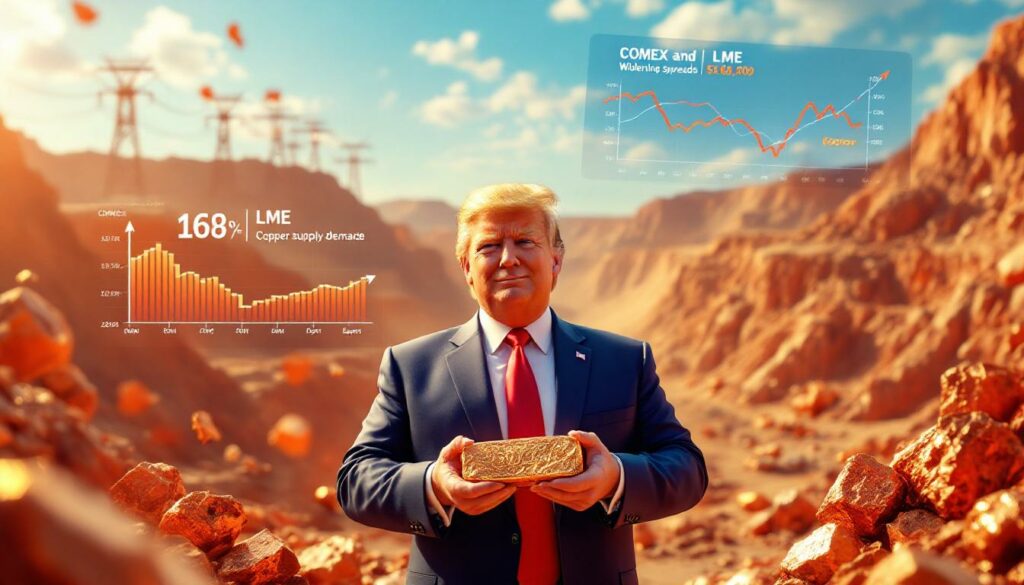How Are Trump Tariffs Reshaping the Copper Market?
The implementation of Trump tariffs has created significant ripple effects throughout the global copper market, shifting trading patterns while having minimal impact on fundamental copper price prediction. These tariffs have primarily caused a redistribution of copper stocks rather than fundamentally altering supply-demand dynamics. The most visible impact has been the widening price spread between COMEX and London Metal Exchange (LME) prices, which has expanded dramatically.
According to recent industry analysis, the price arbitrage between COMEX and LME has increased from a typical 6-7 cents per pound to approximately 70-80 cents per pound—a tenfold increase from the normal median arbitrage of "10 cents per pound or even less." This represents an unprecedented divergence between these two major copper trading venues.
"The Trump tariffs, it's bit of a storm in a teacup. It's just shifting some of the stocks around at the level. Fundamental demand, supply and demand hasn't really been affected. It's just the location of it." — Industry expert from Copperbottomed podcast, 2025
This arbitrage opportunity has prompted a migration of copper stocks toward the U.S. market, unlike previous stock declines which were driven by genuine demand increases and resulted in price appreciation. The current situation represents more of a geographical shift in inventory rather than a fundamental market change.
Current Price Arbitrage Effects
- LME stocks have declined significantly as material shifts to U.S. markets
- Unlike demand-driven stock declines from previous years, copper prices have remained relatively stable
- The tariffs and investment impact appears to be primarily logistical rather than fundamental
- Trading firms with physical copper positions can capture substantial arbitrage profits
This unusual situation highlights how tariff policies can create market distortions without necessarily achieving their intended economic objectives. The arbitrage-driven stock movements represent financial optimization rather than genuine shifts in industrial demand or production.
What Structural Challenges Does the U.S. Copper Industry Face?
Despite tariff protection, the U.S. copper industry faces significant structural challenges that limit domestic production capacity and self-sufficiency. According to USGS data, the U.S. produces approximately 1.1 million tons of mined copper annually but has refining capacity for only about 850,000 tons, creating a substantial processing bottleneck.
This structural imbalance means roughly 250,000-300,000 tons of domestically mined copper must be exported as ore and concentrate due to insufficient domestic refining capacity. Meanwhile, with U.S. consumption reaching 1.8-2 million tons annually, the country must import approximately 800,000 tons of refined copper to meet demand.
U.S. Copper Supply-Demand Imbalance
| Category | Volume (Approximate) |
|---|---|
| U.S. Mined Production | 1.1 million tons |
| U.S. Refining Capacity | 850,000 tons |
| Exported Ore/Concentrate | 320,000 tons |
| Total U.S. Consumption | 1.8-2 million tons |
| Required Refined Copper Imports | 800,000 tons |
This structural reality means that even with tariff protection, the U.S. remains dependent on global markets, particularly China, which now controls over 50% of global smelting capacity. As one industry expert noted, "China's just done this huge buildout of smelters. It's got over 50% of the smelting capacity globally now."
Building new domestic smelting capacity would require guaranteed long-term supply and cost competitiveness against Chinese facilities, presenting significant challenges. The economics of new smelter construction remain problematic, with one analyst explaining, "You're not going to build a new smelter in the States unless you've got guaranteed supply of lots of material."
Economic Considerations for Domestic Refining
- Capital costs for new smelters typically exceed $1 billion
- Environmental permitting for smelters faces significant regulatory hurdles
- Energy costs in the U.S. remain higher than in many competing regions
- Skilled labor shortages affect both construction and operational phases
These structural limitations highlight why tariffs on ASX copper stocks alone cannot reshape the fundamental supply-demand dynamics of the U.S. copper market without complementary investments in processing infrastructure.
What Characterizes U.S. Copper Mining Operations?
The U.S. copper mining landscape is dominated by mature, large-scale operations with relatively low grades compared to global averages. According to a HudBay presentation cited by industry analysts, the largest U.S. open-pit copper mines range from Morenci at approximately 260,000 tons annual production to Ray at 41,000 tons.
Grade analysis reveals these operations typically contain between 0.23% copper content at Morenci to 0.549% at Ray. On a weighted average basis, U.S. open-pit mines operate at grades of approximately 0.35% copper, below the global average of 0.45%. This lower grade profile creates economic challenges for U.S. operations competing in global markets.
Key U.S. Open-Pit Copper Mines
| Mine | Approximate Production | Grade Range |
|---|---|---|
| Morenci | 260,000 tons | ~0.23% |
| Ray | 41,000 tons | ~0.549% |
| Average U.S. Grade | – | ~0.35% |
| Global Average Grade | – | ~0.45% |
The grade differential of 0.1 percentage points may seem minor, but it represents a significant economic disadvantage. At lower grades, more ore must be mined and processed to produce the same amount of copper, increasing both operational costs and environmental footprint.
Operational Characteristics of U.S. Copper Mines
- Most are large-scale, open-pit operations with economies of scale
- Many mines have been operating for decades, with extensive infrastructure
- Lower grades are offset by efficient mining practices and technology
- By-product credits (molybdenum, gold) improve economics at several operations
- High labor costs compared to international operations are partially offset by automation
The maturity of these operations has advantages and disadvantages. While infrastructure is well-established, many operations face challenges with declining grades as higher-grade portions are depleted first. This creates ongoing pressure to optimize operations and reduce costs to remain competitive.
What Exploration Barriers Limit U.S. Copper Development?
The U.S. faces significant barriers to copper exploration that inhibit the development of a robust project pipeline. According to analysis presented by Sheree Leen of Envy Resources, two primary obstacles stand out in limiting new copper discoveries.
Data Limitations
Unlike many mining jurisdictions, the U.S. lacks a centralized repository of geological data. The government does not systematically conduct and share large-scale geophysical and geochemical surveys that could stimulate investment and exploration activity.
This contrasts sharply with countries like Australia and Canada, where government geological surveys provide comprehensive, accessible data that reduces initial exploration risk. The absence of this foundation means exploration companies must invest significantly more in preliminary data collection before target identification.
Regulatory Hurdles
Exploration on public lands faces substantial permitting challenges. Operations disturbing more than 5 acres on Bureau of Land Management (BLM) property require a Plan of Operations and Environmental Assessment, while Forest Service land requires these documents regardless of disturbance size.
These assessments typically require:
- Flora and fauna studies across multiple seasons
- Archaeological surveys with potential tribal consultation
- Public consultation processes with comment periods
- Comprehensive environmental reviews and mitigation plans
- Water and soil baseline studies
The process can take several years and involves substantial costs that most junior exploration companies cannot afford. Industry experts note that "No exploration company which is of the kind of the midtier or lower…are going to be able to afford to do this."
Economic Impact of Regulatory Requirements
- Initial environmental assessment costs can exceed $500,000
- Timeline uncertainties create financing challenges for junior companies
- Capital allocation naturally shifts to jurisdictions with faster permitting
- Early-stage projects face higher hurdle rates to justify regulatory costs
This regulatory framework effectively limits exploration to brownfield expansions by major companies around existing infrastructure, stifling new discoveries. The result is a limited pipeline of new copper projects in the U.S. despite the country's prospective geology.
How Are Global Electrification Trends Driving Copper Demand?
Despite short-term price stability, powerful long-term demand drivers for copper are emerging through global electrification initiatives. The Netherlands provides a compelling case study of the infrastructure challenges facing developed economies pursuing electrification.
According to a Financial Times report cited by industry analysts, over 11,900 Dutch businesses are currently waiting for electricity network connections. This bottleneck highlights the massive infrastructure gap that must be addressed as economies transition to renewable energy and electric transportation.
"Everything is going electric and electricity infrastructure needs to grow massively everywhere." — Jarun Blum, Mayor of Eindhoven
The mayor of Eindhoven has highlighted the need for more than 100 medium-sized substations, 4,000 small substations, and 28,000 technicians to install necessary infrastructure. These figures from just one developed European country indicate the scale of copper-intensive infrastructure required globally.
Copper Intensity of Electrical Infrastructure
- A typical medium-sized substation requires 5-10 tons of copper
- Electric vehicle charging networks require approximately 10kg of copper per charging point
- Grid upgrades to handle increased load can consume 2-3 tons of copper per kilometer
- Renewable energy generation uses 2-5x more copper than conventional power sources
These bottlenecks in the Netherlands foreshadow similar challenges likely to emerge across the European Union as electrification accelerates. Industry analysts describe the situation as a "harbinger of what's likely to occur in other EU countries."
The twin requirements of skilled labor and copper resources underscore the fundamental role copper will play in global energy transition efforts. As one industry expert summarized: "People skills and copper. These are long-term powerful demand drivers."
Electrification Demand by Sector
| Sector | Copper Demand Driver | Estimated Growth Rate |
|---|---|---|
| Grid Infrastructure | Aging replacement + capacity expansion | 4-6% annually |
| Electric Vehicles | 2-4x more copper than conventional vehicles | 15-20% annually |
| Renewable Energy | Solar and wind installation | 10-12% annually |
| Data Centers | AI and cloud computing expansion | 8-10% annually |
This infrastructure buildout represents a sustained, long-term demand driver for copper that transcends short-term market fluctuations and tariff-induced distortions.
Are South American Copper Jurisdictions Becoming More Mining-Friendly?
While Mexico and Colombia maintain challenging environments for mining development, Chile and Argentina have recently implemented significant reforms to streamline permitting processes and attract investment. These changes could alter the competitive landscape for copper project development.
Chile's Regulatory Reforms
On July 1, Chile's Congress passed comprehensive legislation aimed at reducing bureaucratic barriers in the mining sector. This reform package includes:
- Modifications to over 40 industry regulations
- Commitment to reduce processing times from up to 12 years to more manageable timeframes
- Focus on maintaining environmental oversight while eliminating unnecessary procedural hurdles
Economy Minister Nicholas Grow is spearheading efforts to "drastically shorten licensing timelines while maintaining regulatory rigor." This balanced approach aims to restore Chile's competitiveness without sacrificing environmental standards that have become increasingly important to international investors and offtakers.
Argentina's Mining Policy Changes
Argentina has simultaneously introduced changes to its mining framework:
- Amendments to the Mining Investment Law
- Updates to the National Geological Information Bank
- Simplification of investment validation procedures, reducing required data fields from over a thousand to a more streamlined approach
- Creation of a single portal for regulatory submissions
These reforms represent a significant shift in Argentina's approach to resource development, potentially unlocking substantial copper resources in a country that has historically underperformed in mining investment attraction.
Cultural Differences in Mining Acceptance
A key difference between these jurisdictions remains cultural: Chile has a deeply embedded mining culture where copper is widely recognized as the lifeblood of the national economy. Argentina, with its traditionally agricultural economy focused on beef, grain, and wine exports, lacks the same level of public understanding and acceptance of mining activities.
This cultural distinction creates different social license challenges for operators, even as regulatory frameworks become more aligned. Companies developing projects in Argentina must typically invest more heavily in community engagement and social programs to achieve similar levels of acceptance as in Chile.
Which Copper Exploration Companies Are Delivering Promising Results?
The copper exploration sector has seen numerous companies reporting significant drill results in recent months. Several standout performers have delivered exceptional exploration outcomes that highlight the potential for major new copper discoveries despite market challenges.
NGX Minerals ($3.5B CAD Market Cap)
NGX has delivered exceptional results at its Luna project, including:
- 105m at 3% copper and 15g/t gold
- 51m at 11% copper equivalent
- Discovery of ultra-high-grade free gold in quartz veins, adding a new dimension to the project
The company's exploration success suggests potential for gold-dominant mineralization similar to El Indio, creating a dual-metal opportunity with enhanced economics. The high gold grades could significantly reduce the effective cost of copper production through by-product credits.
Mara ($800M USD Market Cap)
Mara has seen its share price double in a month following significant discoveries at Pampa Medina:
- Extensions of mineralization in all directions
- Ultra-high-grade bornite-chalcopyrite and oxide mineralization
- 6m at 12% copper in primary sulfide mantos
The project benefits from a low-altitude location near the Marimaca oxide deposit in the Atacama Desert, offering logistical advantages for potential development. The regionally extensive system of interbedded sedimentary rocks suggests substantial expansion potential.
ATEX Resources ($600M CAD Market Cap)
ATEX continues to deliver strong results at its Chilean project:
- 104m of 1% copper equivalent within 570m of 0.9%
- 1.4km of mineralization above 0.3% in porphyry shell
- High-grade breccia zones including 126m at 2%
These results demonstrate potential for a block cave mining approach, which could optimize capital efficiency and reduce surface disturbance. The combination of scale and grade places this discovery among the more significant recent copper finds.
Cisco Metals ($200M USD Market Cap)
Cisco has successfully revitalized the Gaspé Bay copper system:
- Current indicated mineral resources of 824 million tons at 0.34% copper equivalent
- Recent drilling includes 108m at 0.84% copper
- Exploration of skarn marble horizons adjacent to porphyry intrusion
The company's approach to resource expansion and pit optimization could transform this historical mining district into a significant new copper source. Its location in Quebec provides infrastructure advantages and potential access to lower-carbon energy sources.
What Are the Prospects for Junior Copper Explorers?
Several junior copper explorers are demonstrating significant potential despite their smaller market capitalizations. These companies represent higher-risk, higher-reward opportunities in the copper investment strategies sector.
Fitzroy Minerals
Fitzroy reported impressive results at its Buenretiro project in the Atacama:
- 110m at 1.94% copper in IOCG-style oxide mineralization
- Previous results include 137m at 0.45% and 135m at 0.73%
- Mineralization appears open to the south
The project benefits from favorable infrastructure with proximity to roads and the Pan-American Highway. Its oxide mineralization creates potential for early-stage production utilizing chloride leaching of copper oxides, which could generate cash flow with relatively modest capital requirements.
Faraday Copper
Faraday has seen share price appreciation potentially linked to Trump tariffs:
- Focus on oxide copper production that could bypass refining bottlenecks
- Multi-year price gains despite some lower-grade results
- Potential for SXEW production creating domestic refined cathodes
The company's approach aligns well with the structural challenges facing the U.S. copper market, as its proposed solvent extraction-electrowinning (SXEW) process would produce refined copper cathodes directly, bypassing the smelting bottleneck that affects much of U.S. production.
Gladiator Metals
Gladiator reported strong results in the Yukon:
- 10.5m at 5% copper
- Potential molybdenum and gold credits
- Increasing liquidity and market interest
With multiple drill rigs active, the company is accelerating exploration in a mining-friendly jurisdiction. While the Yukon presents some regulatory oversight, particularly following the Eagle Mine heap leach collapse, it remains significantly more streamlined than many U.S. jurisdictions.
What Does the Future Hold for Copper Markets?
The copper market is positioned at the intersection of several powerful trends that will shape its future trajectory. The interplay between Trump tariffs and these structural factors will determine market dynamics in both the short and long term.
Long-Term Demand Drivers
- Electrification Infrastructure: The global transition to renewable energy requires
Ready to Stay Ahead of Major Mineral Discoveries?
Discovery Alert's proprietary Discovery IQ model delivers instant notifications on significant ASX mineral discoveries, turning complex data into actionable investment insights. Explore our dedicated discoveries page to understand how major mineral discoveries can lead to exceptional market returns and begin your 30-day free trial today.




